Is there a better American snack than beef jerky or beef sticks? Hardly. It's no surprise that these two snacks are so ubiquitous and have achieved a cult status in this country. Both come with a multitude of flavors and textures to satisfy various tastes.
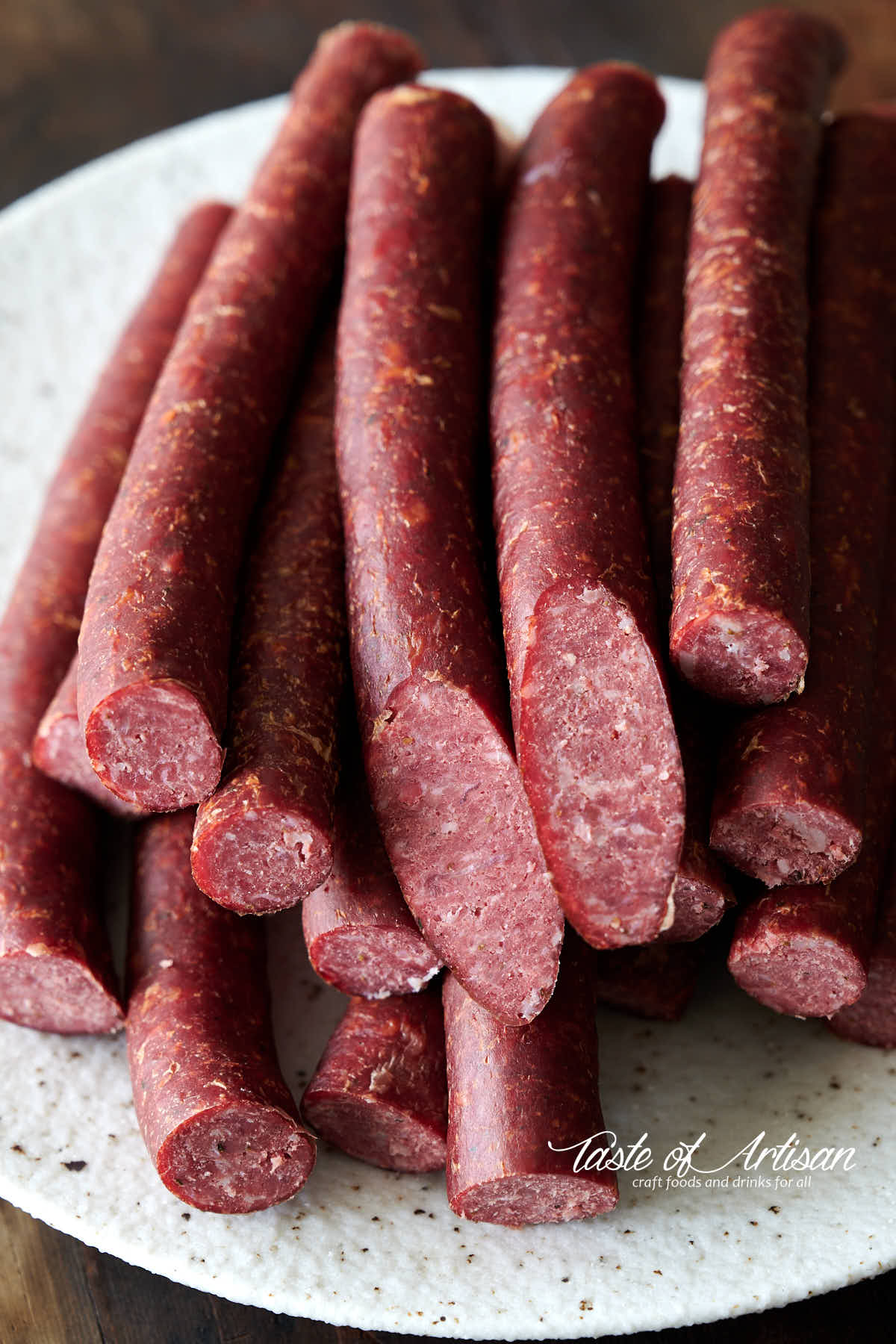
A lot of commercially prepared beef sticks have a long shelf life and require no refrigeration. This is achieved by adding salt and increasing acidity, by a lot. Most of them, I find, are overly acidic for my taste. Those that aren't, they need to be refrigerated, which is fine. Then there is the taste and the flavor. You may find a perfectly tasty beef stick but it may be too acidic, or it may be the other way around.
Making beef sticks
So, what's the solution? You guessed it right, make your own beef sticks. They are surprisingly easy to make at home. My recipe started from the sausage stick recipe published by Rytek Kutas in his Great Sausage Recipes and Meat Curing book. I tried that recipe many years ago and transformed it into what I now consider the best beef stick recipe, for my taste at least.
This recipe requires fresh beef chuck, 20/80 fat to meat ratio, though any beef cut can be used. The spices are fairly basic and not overpowering. I also use just a bit of fermento to add just a touch of a tang. Fermento can be skipped though, I sometimes omit it and the final product is just as good, with a slightly different taste profile. Rytek Kutas's recipe is quite heavy on fermento by the way, about 3 times as much as what I use in my recipe.
These beef sticks are made with either thin sheep casings (expensive), or with 18-22 mm edible collagen casings. Though I often prefer natural casings, I tend to use collagen casings to make beef sticks 90% of the time.
Upon stuffing, beef sticks are smoked for a couple of hours, until a desired color is obtained. I use hickory or pecan, those work very well.
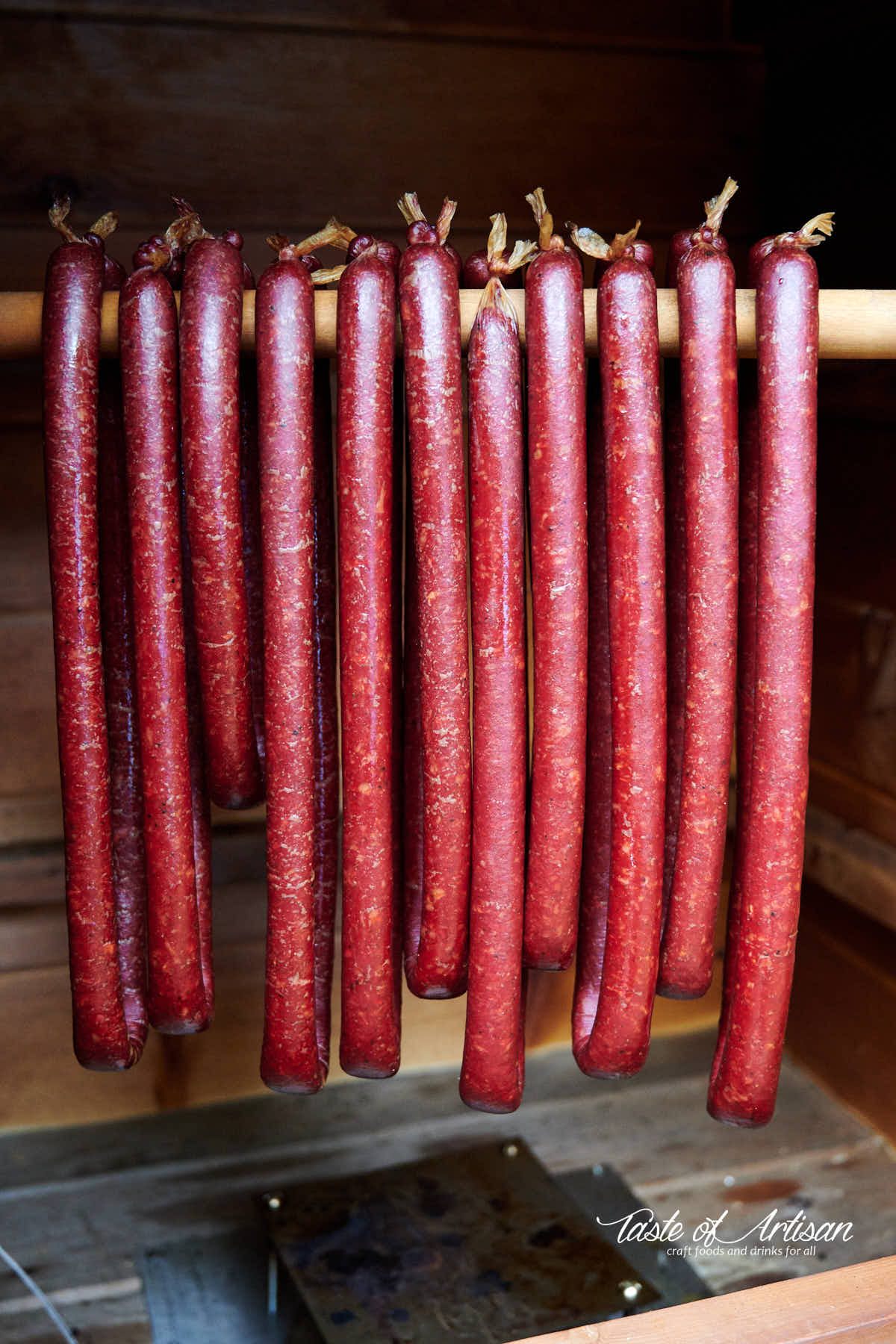 After smoking, the sausages are poached in hot water to bring the internal temperature to 152F.
After smoking, the sausages are poached in hot water to bring the internal temperature to 152F.
I tried 'baking' them in the smokehouse first, but gave up after 40 minutes as the internal temperature was rising very slowly and the fat near surface started to melt.
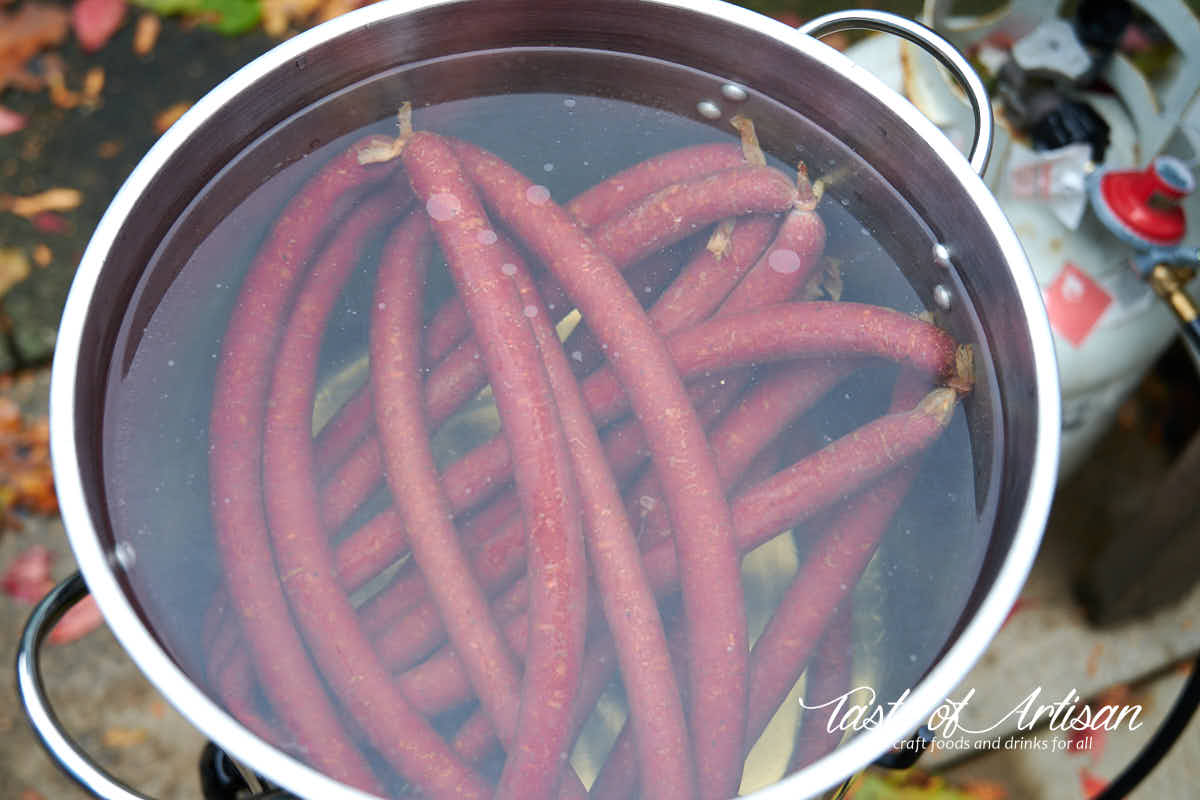
Fully cooked beef sticks are showered in cold water, dried, and refrigerated.
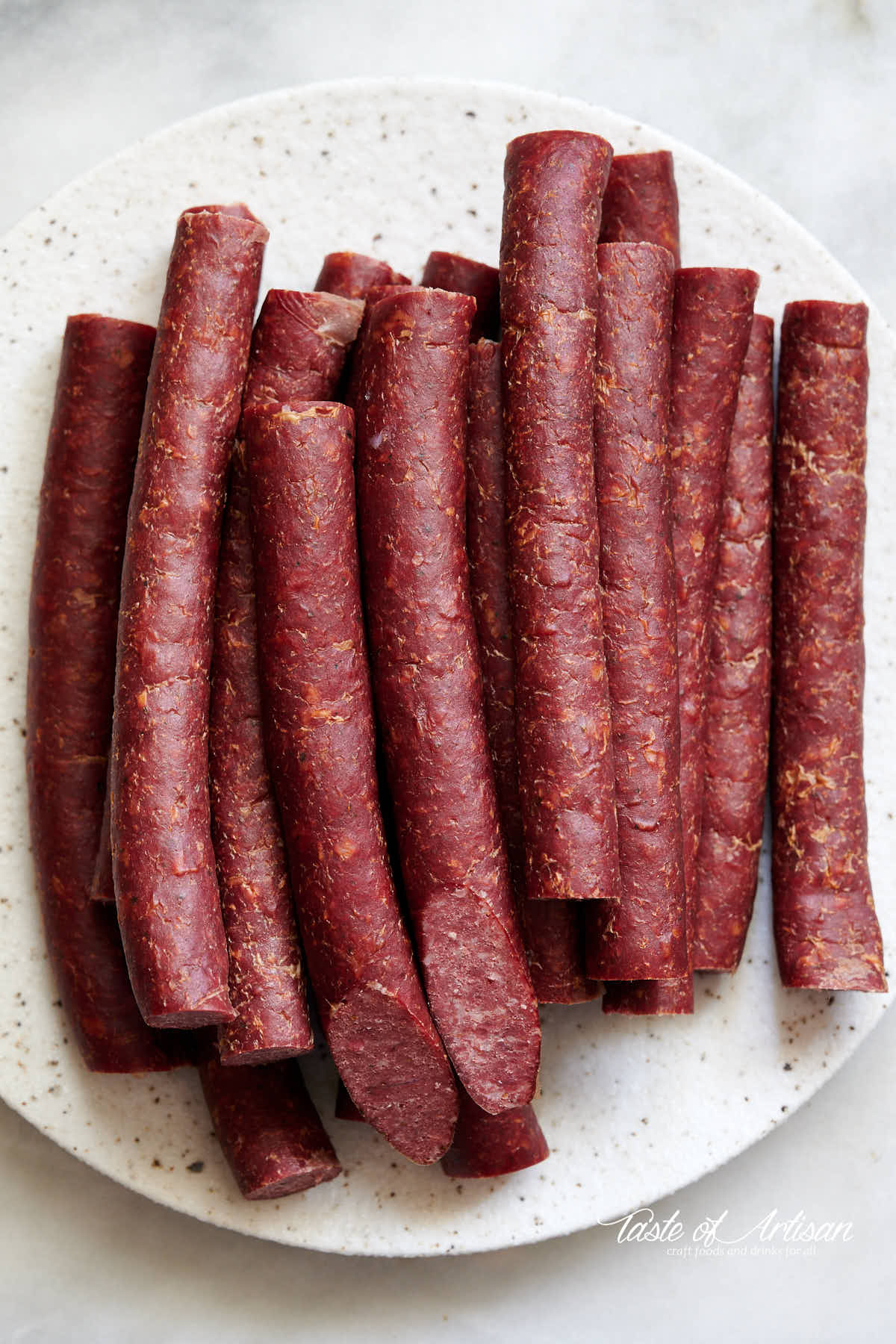
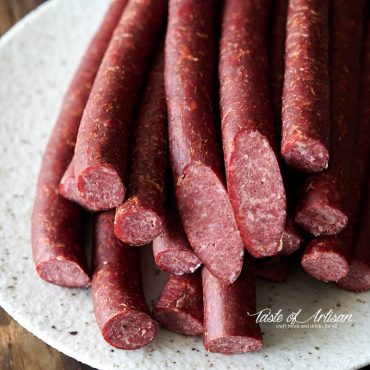
Ingredients
- 3500 g beef chuck about 7.7 lbs; 20/80 fat to lean meat
- 7.5 g Cure #1 about 1.5 level tsp
- 45 g kosher salt about 2.5 Tbsp
- 6.5 g ground black pepper about 2 tsp
- 6 g granulated garlic about 2 tsp
- 8 g granulated onion about 2 1/2 tsp
- 42 g Fermento about 6 Tbsp
- 5 g dextrose about 1 tsp; can be substituted for white sugar
- 8 g mustard powder about 1 Tbsp
- 5 g celery seed about 2 tsp
Instructions
- Grind the meat through a 3/16" (4.5 mm) grinder plate.
- Add the rest of the ingredients and mix well. I find that a stand mixer with a paddle attachment works very well for mixing.
- Stuff into 18-24 mm natural or collagen casings.
- Tie into 24" rings (24" total length, 12" top to bottom when the ring is formed).
- Transfer to the smoker and dry without smoke for 30-45 minutes at 110F, or until dry to touch.
- Raise the temperature to 130F and smoke for 2-3 hours or until the desired color is obtained.
- Transfer to a large pot with water preheated to 165F. Poach for 15 minutes or until the internal temperature reaches 154-158 F.
- Shower with cold water for about 5 min, then let cool down and dry.
- Cut into 6" sticks.
- Store in a refrigerator.
Nutrition


Don says
how long do the beef sticks last in the refrigerator?
Victor @ Taste of Artisan says
Up to 4 weeks easily. If you let them dry in a cool room (55F - 57F), like a garage in the winter, or a cold room, for 3-5 days, they will stay fresh in a fridge for 2-3 months in my experience.
Vacuum sealing also helps extend shelf life.
Perry says
Hi Victor, the instructions for some collagen casings say that you can’t poach them because they break down. What are the collagen cases that you use made from or which are ok to use for poaching?
Victor @ Taste of Artisan says
Hi Perry, I had no idea that you couldn't poach at least some of them. Mine are Nitta Casings, see the full label below.
https://tasteofartisan.com/wp-content/uploads/2024/01/IMG_3278.jpg
Richard says
Hi Victor. What is the best way to dry beef sticks after reaching the internal temperature of 154 deg
Victor @ Taste of Artisan says
Hi Richard, it depends on what you have equiopment-wise. A curing chamber set to about 70% RH and 55F will be great. This time of the year, I just hang my sausages in the unheated garage. It's about 48-50F and 62% RH but it works very well for drying sausages, I've done it several times last year and will be doing it again this year. If you have a cold room, that will work too. Mine right now is about 50-55F and 52% RH. Drying in the fridge works too, I tried that a few times and the results were very good. Just don't over crowd them. Best to lay them out on a tray or a cooling rack and let them dry for a few days, then wrap or seal. You can also wrap them in unglazed butcher paper and keep in the fridge for a week or so. Just try to keep the sausages loose in 1-2 layers at the most. Good luck.
Marsha says
Hey Victor - these look wonderful. Any ideas for dumbing-down your recipe for those of us who don't have a smoker? 😉
Victor @ Taste of Artisan says
Marsha, without a smoker you could dry cure them if you have a meat curing chamber, but that will require some recipe changes, and not a simpler process. You could put them in the oven and cook at 175F or so, with convection, until the internal temp hit at least 154F. They won't have the smoky flavor but will still taste good.
Mat says
Victor, have you ever used ground elk or venison for your sticks? What do you recommend for adding fat into the mixture?
Victor @ Taste of Artisan says
Mat, I haven't tried this recipe with game meat. That said, you can use lean venison, moose or elk meat with pork fat or pork trimmings using 70/30 and 60/40 ratios, respectively. This is what is typically recommended for wild game sausages. Some go even up to 55% fat. Personally, I like my sausages leaner... for game meat sticks I'd use 20% pork belly, maybe 25%. I'd suggest trying a small batch first with 20% and 25%, maybe even 30%, and see which one you like best. Tastes differ, so it's always a good idea to try for yourself before you do a big batch.
Ted says
I would like to use the F-LC culture that I have rather than Fermento.
Would I use the same 0.24 g F-LC / 1 kg meat ratio and 24-hour ferment methods used for the summer sausage as I would with the beef sticks or would you recommend something else?
Victor @ Taste of Artisan says
The same will work here. Good luck.
gord rowe says
should i add water to the pepperoni sticks
Victor @ Taste of Artisan says
I don't in this recipe but you certainly can.
Eric says
Hello,
Great article. I have a couple of questions.
1. What is a serving size?
2. Can you finish them in the smoker at a higher temperature instead of poaching them?
Thanks!
Victor @ Taste of Artisan says
Eric, the serving size is 1/40th of the entire recipe or about one 6-inch stick. It's in the header of the recipe card.
Yes, you can totally finish them in the smoker.
I finished 38-40mm thick Chicken Andouille (will post recipe soon) without too much hassle... Poaching is easy, quick, predictable. A little less smoky, a touch less color is the minor downside. Finishing in the smoker - can be very, very long (too cold outside, windy, not enough insulation in the smoker, thick sausage), too much fat melting as a result, drying out. For my Andouille, I put a bowl of boiling water on top of the heat deflector, it helped. The more humidity in the smoker the faster the internal temp will be reached. That said, both methods are very good and I like both. Can't go wrong either way.
Eric says
Thanks Victor! I can't wait to try this.
Faith Martin says
Been looking for an easy recipe such as this. Can’t wait to try it.
Do you have a recipe using fennel seeds or could they be swapped out with the celery seeds?
Thanks Faith Martin
Victor @ Taste of Artisan says
There are really no hard rules in sausage making, you decide what flavor profile you want to achieve. I've made many sausages with fennel, the ratios I like are 2g per kilo of meat to 3g per kilo. This will give you a moderate fennel flavor. For mild add 1 gram. You can also use fennel pollen, I like it, but it's stronger that you'd want to decrease the ratio by about half. You can add fennel to the existing recipe or substitute celery out. Your choice.
Nicholas Checki says
What if I want to add teriyaki flavor to your recipe how would I incorporate that
Victor @ Taste of Artisan says
Hi Nicholas, I am quite puzzled here, to be honest. Teriyaki sauces have many ingredients in them, if you want to add it to the sausage you may have to make quite a few adjustments, it's not so simple if you want to maintain the balance and the flavor will definitely change. I could suggest looking at this thread https://forum.sausagemaking.org/viewtopic.php?f=2&t=11458 as a start. Hope it helps.
Ryan says
Do you really need the fermento in the beef sticks when you already have cure #1 in the recipe or add more cure#1 to it
Victor @ Taste of Artisan says
Each serves a different purpose so yes, you'd want to use both. You can skip the fermento altogether though. In this recipe, it adds some tang to the taste is all.
Dale Ray says
I've been making sausages for a couple of years now. Love my new retirement hobby. My next sausage will be Krawkow Kielbasa. Thanks for your tips.
Victor @ Taste of Artisan says
You are very welcome. Try the kabansos sausage. Delightful.
Rich says
I made the pickled sausage I ask your opinion on a few weeks ago. Turns out I used the beef stick recipe with less fat removed the casing then put them in the brine. This might not be for everyone but I relive a part of my childhood when I taste on of these. In my area they are served with a cracker. My dad would stop at the local bar for a few beers and would buy my silence for a pickled sausage. They were 10 cents back then.
Victor @ Taste of Artisan says
Hi Rich, how did they turn out?
Rich says
They were really good. My grandson even liked them. The recipe calls for the brine to be brought to a boil and poured over the jared sausage. This cause fat to render out some. Next time I will boil then cool.
Christine says
Do you think I could do this with turkey instead of beef?
Victor @ Taste of Artisan says
Christine, yes it will work but you will need to make a few adjustments. Use 20% fat and skins to make it palatable. The rest can be a 50/50 mix of white/dark meat or just dark meat. Cook to at least 160F internal as this is poultry. Oh, I grind fat/skins very finely (1/8" plate) or emulsify if I feel like it. The rest of meat can be ground on a 3/16th plate or even coarser if you like.
alex says
No comments I didn't try yet
Rich. A says
I would like to make some pickled sausage sort of like the canned version. Do you think this sausage recipe would be good for pickling? If not could you recommend a sausage recipe that would work for pikling.
Victor @ Taste of Artisan says
Hi Rich, I haven't tried making pickled sausage but I understand that any cooked sausage will work and it looks like many recipes for pickled sausage use kielbasa. I think you should be able to use my beef sticks for pickling just fine and I am sure they will taste great but the only thing I would change in the recipe is not use any Fermento as you will be adding acidity with the pickling brine. If you want to use kielbasa, my Swojska recipe is very good, many love it. Garlic keilbasa is very good too. Kabanos recipe is outstanding. It has more sugar in it than most other kielbasa recipes that I've tried, I think it will be great for pickling. As a matter of fact, I am going to try that myself;)
Rich says
I have made pickled sausage with my kielbasa and it was really good. But some others that tried it, although they liked it the bits of fat was a turn off. So I will try a leaner finer sausage. I will try you beef sticks.
Victor @ Taste of Artisan says
Oh, I am very familiar with the fat problem that you described;) I do two things to combat that problem - go lean or grind very fine (3mm plate). Beef sticks aren't super lean as they use chuck. I'd say grind the meat on a 1/8" (3mm) plate. Or try my Krakow of Lisiecka kielbasa recipes, they are very lean. You can grind them finer and stuff into thin casings (sheep or 18-20mm collagen).
Dean says
What is shelf life of beef sticks refrigerated?
Victor @ Taste of Artisan says
These will stay fresh in a fridge for a few weeks and even months if you dry them a little. I dry mine at 75% rH and 55F in my curing chamber but I noticed that they dry up pretty good in the fridge too. I haven't tested this with these beef sticks but I've had a ring of Polish kielbasa that was forgotten and that sat in the fridge for a good year on the bottom shelf and it was quite dry by then but tasted very good and smelled amazing.
Paul says
Hi Victor, my name is Paul. I enjoyed reading your recipe. Im new to making jerky. I would really like to pick your brain if your willing to share your experiences.. im planning to market jerky locally here in Indiana. Im so confused on Curing salt.. im using Prague #1 powder. Suppose to give 6 month shelf life.
Victor @ Taste of Artisan says
Paul, to my knowledge, Instacur #1, Prague #1, Cure # are all different brand names for the same thing. I'll be more than happy to share my experience, so just ask away.
JAY says
The beef sticks came out really good. First time making these and I am very happy with how they turned out. The only problem is I made a small batch. Thanks for the recipe and detailed instructions which were very helpful.
Victor @ Taste of Artisan says
You are welcome.
Rae says
I don't have a smoker. Can I use a dehydrator instead?
Victor @ Taste of Artisan says
I am sure you can, I've seen people make beef sticks in a dehydrator. It's going be different but still good I am sure.
Rae says
Maybe add a little liquid smoke to achieve the smoked flavor.
Victor @ Taste of Artisan says
That's a good idea.
Sam says
Great recipe. I’m wondering if there is a need for the fermento. It seems like they are being fully cooked, so with the cure #1 being added, doesn’t that take care of it from a safety perspective? Most recipes I have read that include fermenting don’t include the cooking step so I’m curious about that.
Victor @ Taste of Artisan says
Sam, acidity is just another safety hurdle to keep the meat safe to eat. There are quite a few recipes out there that combine fermentation and cooking, like the widely known summer sausage. Some are dried after cooking. These are known as semi-dry sausages. The final product is usually shelf-stable and does not need to be refrigerated. In this particular recipe, fermento is more for taste than safety as you'd keep the sausages in the fridge anyway. Most beef ticks have a degree of acidity, at least the ones that I've tried, it's characteristic of this type of sausage. You don't have to use it though. You can also use any other acidic component if you want, like wine, apple cider vinegar, lemon juice, citric acid...
Sam says
Great advice, and thanks for that elaboration. I’m gonna try this tomorrow but don’t have fermento so I’ll replace with some type of vinegar!
Victor @ Taste of Artisan says
You are welcome. Happy smoking!
Matthew Gander says
Hey Victor,
Beef sticks are next for me after the summer sausage turned out so well. Any reason why I can't do 2800 g of moose and 700 g of pork back fat for an 80/20 mix?
Victor @ Taste of Artisan says
Hi Matthew, glad to hear about your success in making moose summer sausage. I think 80/20 will work well in this recipe. When smoking, keep the temperature at 130F, 135F tops. You want to preserve that fat.
Norm says
Man those beef sticks look good. You nailed them.